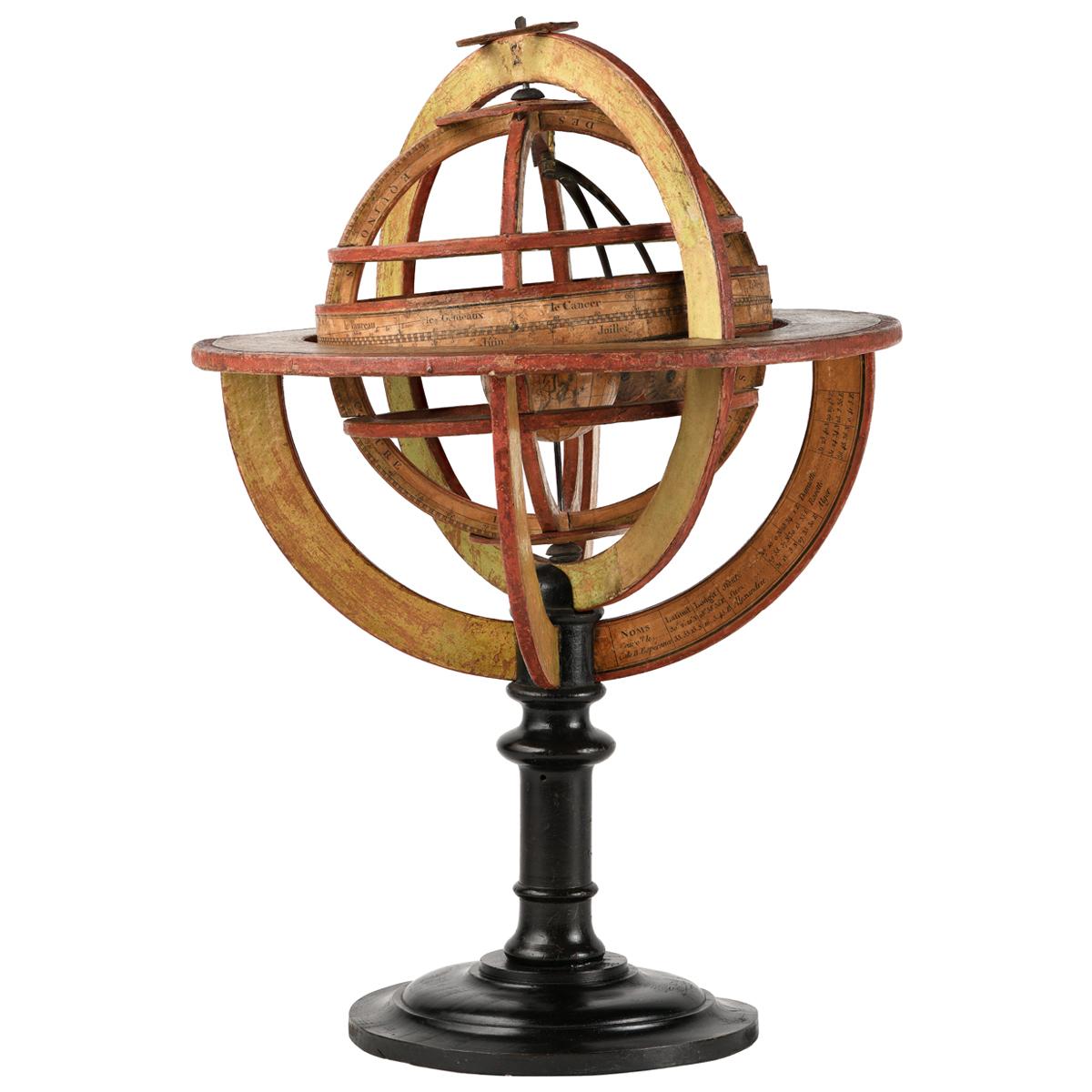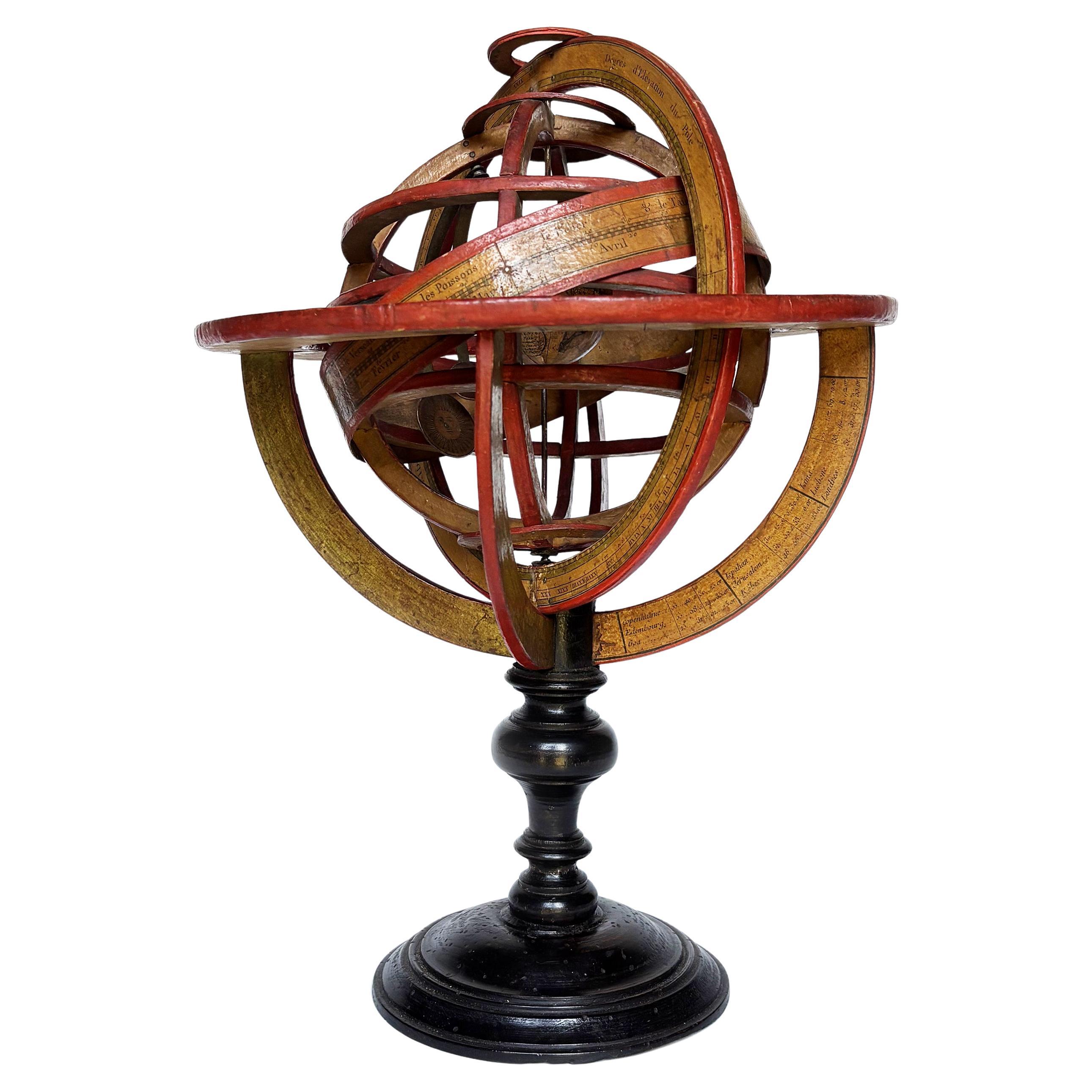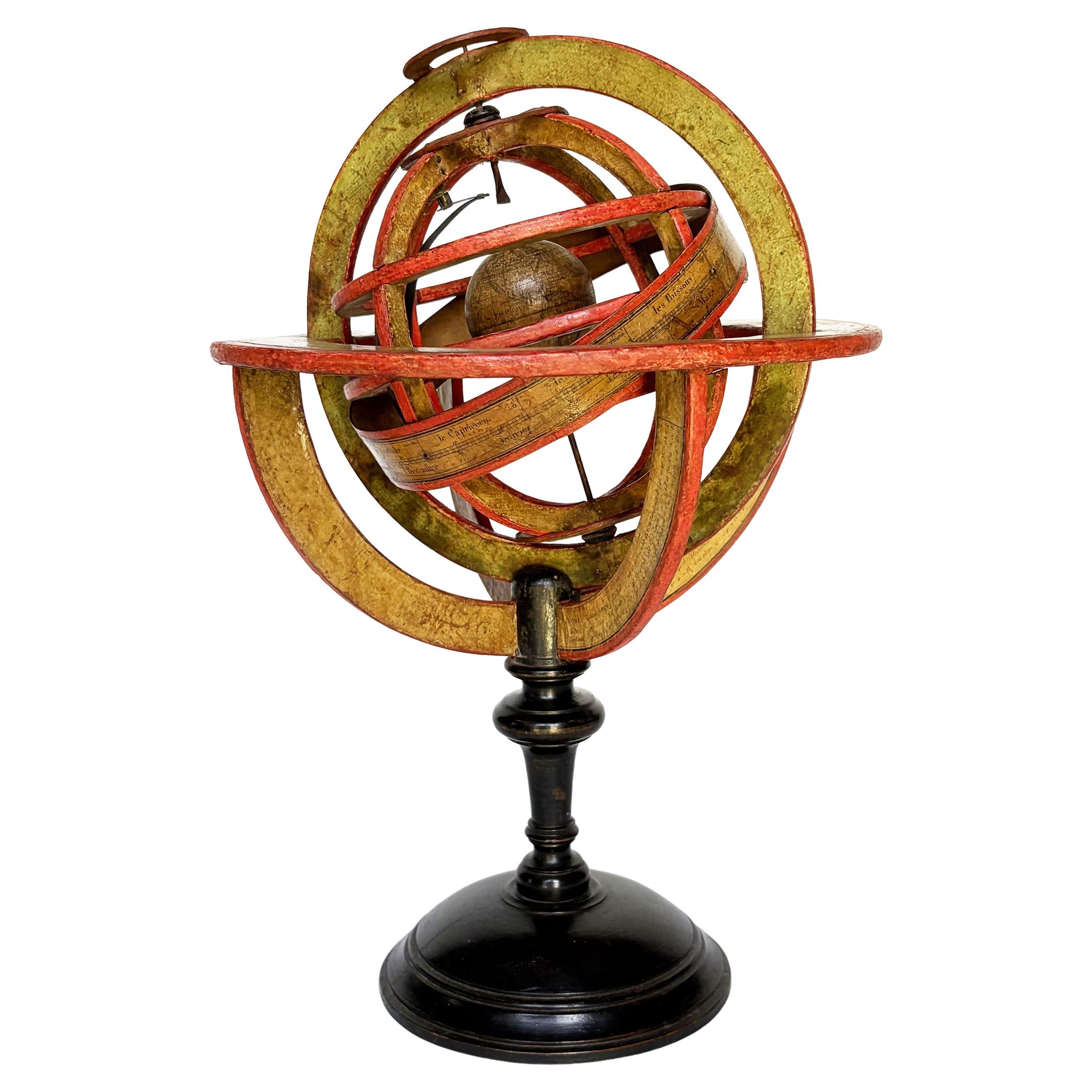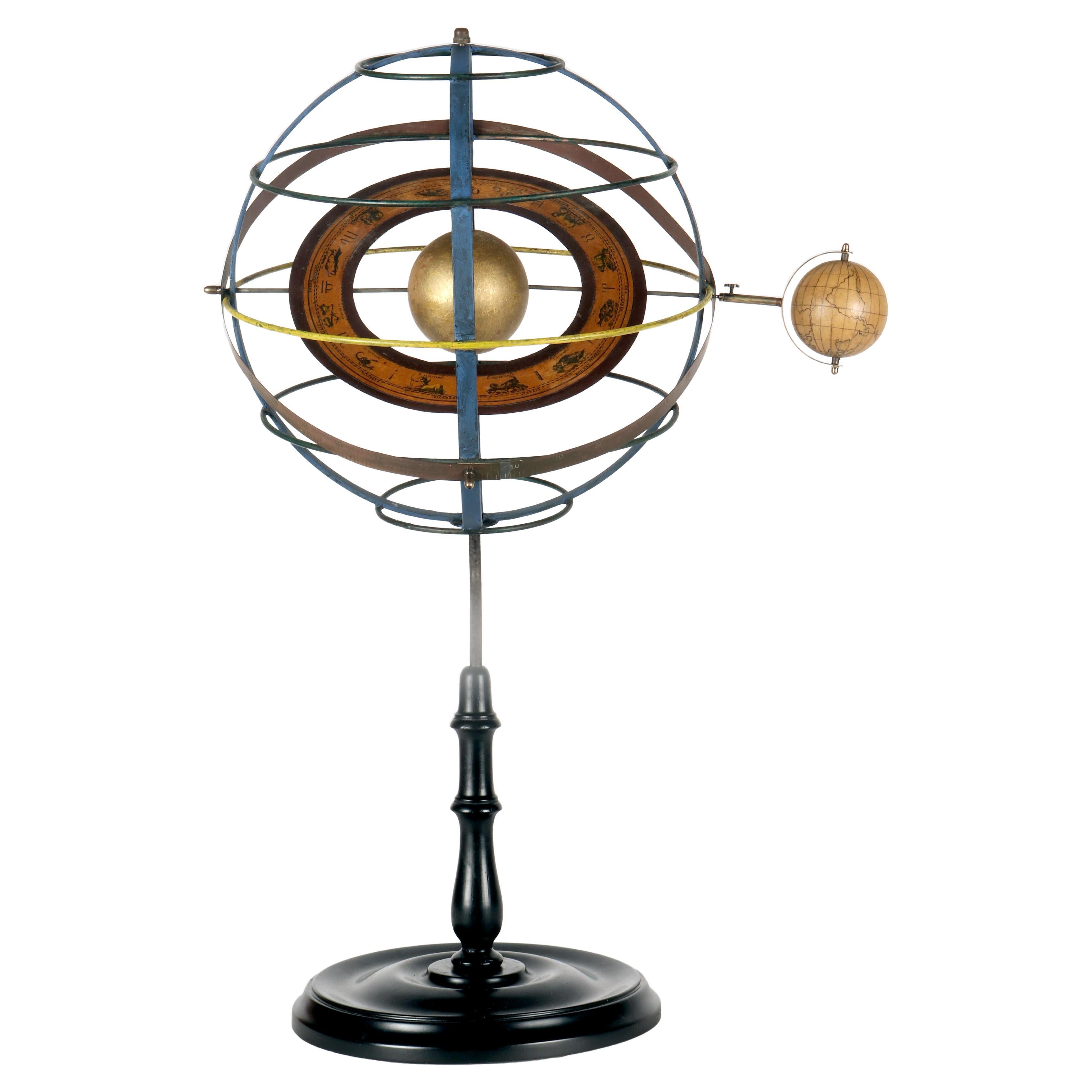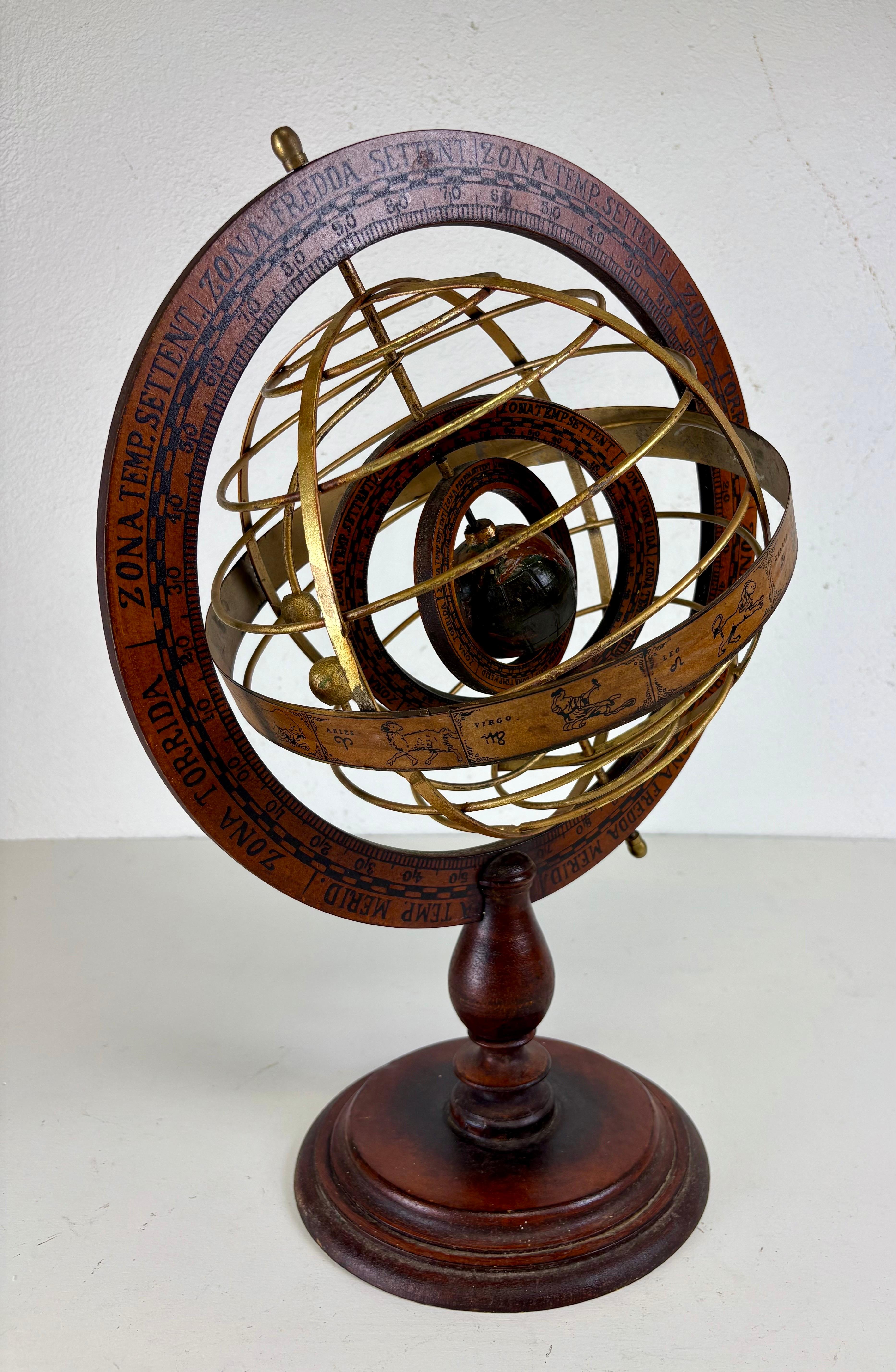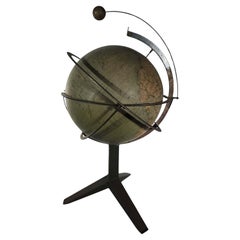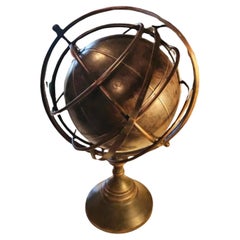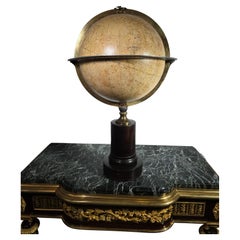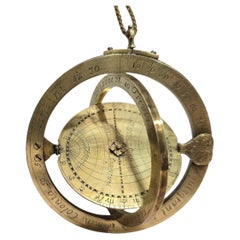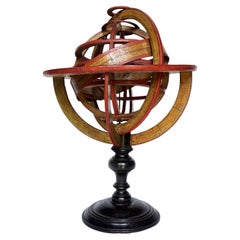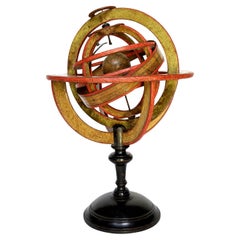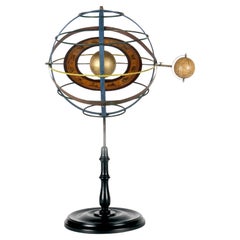Items Similar to Rare 19th-Century Armillary Sphere by Faustino Paluzie — Barcelona, circa 1880
Want more images or videos?
Request additional images or videos from the seller
1 of 12
Rare 19th-Century Armillary Sphere by Faustino Paluzie — Barcelona, circa 1880
$6,787.76
£5,159.83
€5,740
CA$9,539.19
A$10,372.51
CHF 5,465.30
MX$125,995.85
NOK 68,709.83
SEK 64,409.91
DKK 43,935.16
About the Item
Exceptional and very rare armillary sphere made in Barcelona around 1880 by Faustino Paluzie, one of the most important Spanish makers of scientific and didactic instruments of the 19th century.
Constructed from iron, wood, paper, and brass, this finely crafted model combines precision and decorative appeal. The paper rings are printed and hand-colored with celestial and terrestrial references, mounted on a turned wooden base and brass axis.
Dimensions:
Height: 53 cm (20.9 in)
Diameter: 33 cm (13 in)
A highly collectible and hard-to-find example of Paluzie’s educational globes and instruments, representing the excellence of late-19th-century Catalan craftsmanship. Ideal for collectors of antique scientific instruments or early cosmographical models.
- Dimensions:Height: 20.87 in (53 cm)Diameter: 13 in (33 cm)
- Materials and Techniques:
- Period:
- Date of Manufacture:1880
- Condition:
- Seller Location:Madrid, ES
About the Seller
4.8
Platinum Seller
Premium sellers with a 4.7+ rating and 24-hour response times
Established in 2005
1stDibs seller since 2021
385 sales on 1stDibs
Typical response time: 1 hour
- ShippingRetrieving quote...Shipping from: Madrid, Spain
- Return Policy
Authenticity Guarantee
In the unlikely event there’s an issue with an item’s authenticity, contact us within 1 year for a full refund. DetailsMoney-Back Guarantee
If your item is not as described, is damaged in transit, or does not arrive, contact us within 7 days for a full refund. Details24-Hour Cancellation
You have a 24-hour grace period in which to reconsider your purchase, with no questions asked.Vetted Professional Sellers
Our world-class sellers must adhere to strict standards for service and quality, maintaining the integrity of our listings.Price-Match Guarantee
If you find that a seller listed the same item for a lower price elsewhere, we’ll match it.Trusted Global Delivery
Our best-in-class carrier network provides specialized shipping options worldwide, including custom delivery.More From This Seller
View AllAntique Orrery – Tellurium by Paravia, Torino (1900, Italy)
Located in Madrid, ES
Rare and collectible orrery (tellurium) produced by the renowned Italian maker Paravia, Torino in 1900. This finely crafted planetary model illustrates the Earth-Sun-Moon system, dem...
Category
Early 20th Century Scientific Instruments
Materials
Paper
Rare English Nautical Globe with Armillary Sphere (1930) 20th Century
Located in Madrid, ES
Rare English Nautical Globe with Armillary Sphere (1930) 20th Century
Good condition
magnificent globe, with a leather-covered wooden interior terrest...
Category
Early 20th Century English Modern Nautical Objects
Materials
Metal
19th Century Celestial Globe by Charles Dien, Signed and Dedicated to M. A. Bouv
Located in Madrid, ES
Rare and elegant 19th-century celestial globe signed: "Dédié à M. A. Bouvard... / par Ch. Dien." Created by Charles Dien, a noted French globe maker, this piece features beautifully ...
Category
Antique 1850s Scientific Instruments
Materials
Fruitwood
Planispheric Astrolabe – Equinoctial Dial, late 16th–early 17th century
Located in Madrid, ES
Origin: Probably Southern Germany (Nuremberg or Augsburg) or the Flemish region (Louvain or Antwerp).
Date: circa 1580–1620
Material: finely engraved brass
Diameter: 9 cm
A beautifu...
Category
Antique 16th Century Scientific Instruments
Materials
Brass
Rare Paluzie Globe from the 19th Century
Located in Madrid, ES
Rare Paluzie globe from the XIX century. Desktop globe from the xix century made by the house: Faustino Paluzie-Barcelona. The base is made of ebonized w...
Category
Antique 19th Century Spanish Baroque Desk Sets
Materials
Wood
Large Globe by Emile Bertaux 19th Century
Located in Madrid, ES
Large globe by Emile Bertaux 50 cm diameter. It is 90 cm high. The base is made of turned wood.
Good condition.
Category
Antique 19th Century French Baroque Desk Sets
Materials
Wood
You May Also Like
Ptolemaic Armillary Sphere Charles-François Delamarche Paris, 1805-1810 Circa
By Charles Francois Delamarche
Located in Milano, IT
Charles-François Delamarche
Ptolemaic armillary sphere
Paris, circa 1805-1810
Wood and papier-mâché
covered with printed and partly hand-coloured paper
It measures 15.74” in height, ...
Category
Antique Early 1800s French Empire Scientific Instruments
Materials
Paper, Wood
Ptolemaic Armillary Sphere, Charles-François Delamarche, Paris, ante 1798
By Charles Francois Delamarche
Located in Milano, IT
Ptolemaic armillary sphere
Charles-François Delamarche
Paris, ante 1798
Wood and papier-mâché
covered with printed and partly hand-colored paper
It measures 15.55 in in height x Ø 10...
Category
Antique 1790s French Other Scientific Instruments
Materials
Wood, Paper
Ptolemaic Armillary Sphere, Charles-François Delamarche, Paris, ante 1798
By Charles Francois Delamarche
Located in Milano, IT
Ptolemaic armillary sphere
Charles-François Delamarche
Paris, ante 1798
Wood and papier-mâché
covered with printed and partly hand-colored paper
It measures 16.37 in in height x Ø 10.94 in (41.60 cm - Ø 27.80 cm)
It weights 2.33 lb (1,058 g)
State of conservation: consistent with its age and use, the paper shows some signs of use, stains and abrasions.
The sphere is Ptolemaic, with the Earth placed at its center, surrounded by the Moon and the Sun mounted on two metal arms.
The sphere is composed of six horizontal and two vertical rings (armillae), each bearing graduations and its own name.
The first horizontal ring is illegible. The others, in descending order are: North Pole, Tropic of Cancer, Equator, Tropic of Capricorn, South Pole.
The vertical rings consist of two double meridians.
The sphere is then connected to the large meridian by two pins, a vertical ring inserted perpendicularly into the circle of the Horizon, in turn supported by four semicircles connected to the turned and black-stained wooden base.
Each element is covered with printed paper. It contains various pieces of information: latitudes, length of days, names and zodiac symbols, calendar, wind directions, etc.
The vertical circles mention the latitudes and longitudes of different cities: Rome, Bordeaux, Madrid, Boston, Batavia (Jakarta), Acapulco, etc.
Even the small terrestrial globe is covered with printed paper: continents and oceans appear with numerous geographical markings indicating the most recent explorations.
In the Pacific Ocean, west of South America bears the following inscription:
GLOBE
TERRESTRIAL
à Paris
chez Delamarche Géog
Rue du Foin Jacques
Au Collège de
M.e Gervais
The North American coasts are well delineated and California appears correctly as a peninsula - reports from Spanish explorers in the region had given rise to confusion as to whether it was connected to the mainland or not. The geographical nature of California was confirmed after the explorations of Juan Bautista de Anza (1774-1776).
Alaska is not described and is only partially traced; it would become part of the United States in 1867.
Various Pacific islands are indicated.
Australia (the name definitely used from 1824) is called "Nouvelle Hollande."
Tasmania is still represented as a peninsula and this is an important detail for the dating of our armillary sphere.
The island is separated from Australia by Bass Strait, which was crossed by Matthew Flinders for the first time in 1798, showing that it was not a peninsula. Delamarche certainly would not have waited a long time to update such an important geographical datum: presumably he did so shortly after receiving the news.
Charles-François Delamarche (1740-1817) founded his laboratory around 1770 and, in a few years, he became the most famous French cartographer and globe maker between the 18th and 19th centuries. After having acquired the laboratory of the late Didier Robert de Vaugondy (1723-1786; himself a renowned cartographer who continued the family business founded by his grandfather Nicolas Sanson in the seventeenth century) and after having purchased, between 1788 and around 1800, the businesses of Jean-Baptiste Fortin (1750-1831) and Jean Lattré (around 1750-1800), he began to call himself "Successeur de MM. Sanson and Robert de Vaugondi, Géographes du Roi and de M. Fortin, Ingénieur-mécanicien du Roi pour les globes et les sphères."
Thus, at the end of the eighteenth century, Delamarche possessed the warehouse stocks, as well as the manufacturing skills of the globes of his main rivals in Paris.
In addition to this aggressive acquisition policy, the key to its success also lay in the combination of high-quality cartography combined with extremely attractive globes and armillary spheres; and, of course, its famous red paint finishing touch.
His laboratory was located on Rue de Foin St Jacques "au Collège Me. (or "Mtre") Gervais" in the Latin Quarter of Paris until around 1805, when he moved to rue du Jardinet No. 13.
On the death of Charles-François in 1817, the reins of the company passed to his son Félix (1779-1835), who continued to publish, often in collaboration with the engraver Charles Dien, Sr. In 1835 the company first moved to rue du Jardinet No. 12 and a little later to rue du Battoir No. 7.
Bibliography:
Dekker, Elly, et al. Globes at Greenwich...
Category
Antique 1790s French Other Scientific Instruments
Materials
Wood, Paper
A Copernican armillary sphere, Paravia, Milan, Italy 1930
Located in Milan, IT
A Copernican armillary sphere made of iron, paper, brass and wood, with the Sun inside, and the Earth on the outside, made of wood and covered with paper. Pedestal made of turned and...
Category
Mid-20th Century Italian Scientific Instruments
Materials
Brass, Iron
Vintage Armillary globe or sphere
Located in Allentown, PA
This is a vintage Armillary globe or sphere. The sculptural globe has rings of metal and wood with depictions of the zodiac signs painted on the wood portion. The globe rings are gil...
Category
1990s Mobiles and Kinetic Sculptures
Materials
Metal
French Hand Carved Wooden Armillary
Located in Dallas, TX
A rare and visually captivating French hand carved armillary sphere, dating to around 1900. Crafted entirely of wood and meticulously hand painted, this antique scientific model...
Category
Antique Early 1900s French Scientific Instruments
Materials
Wood, Paint
